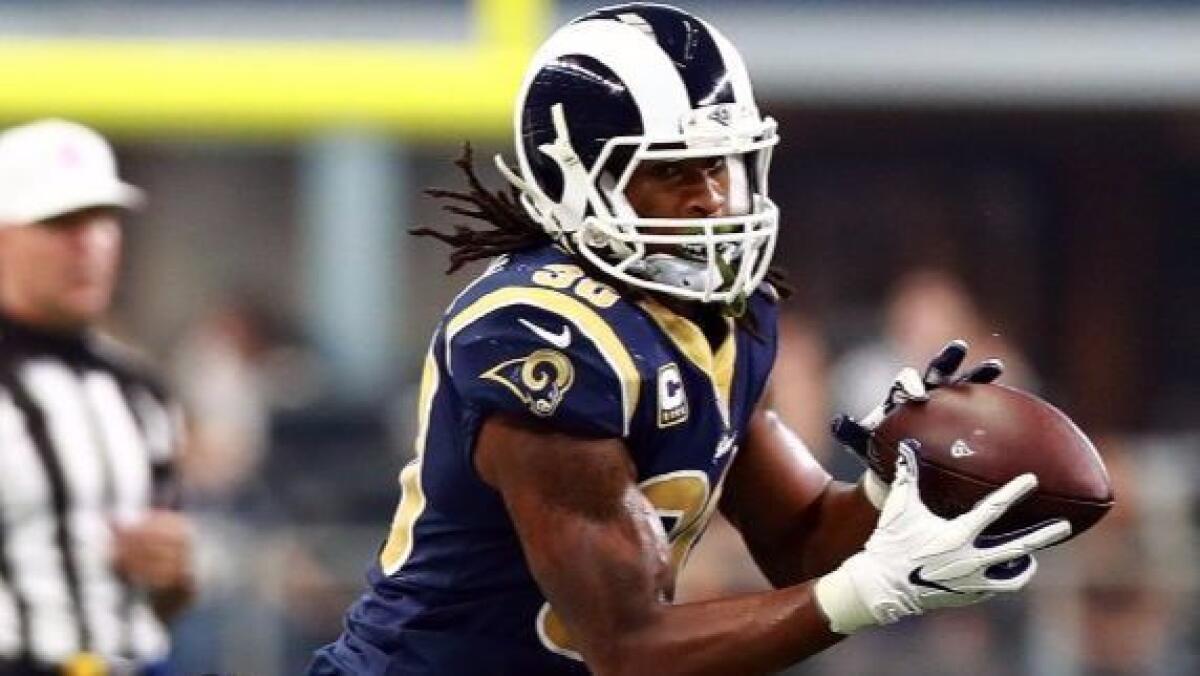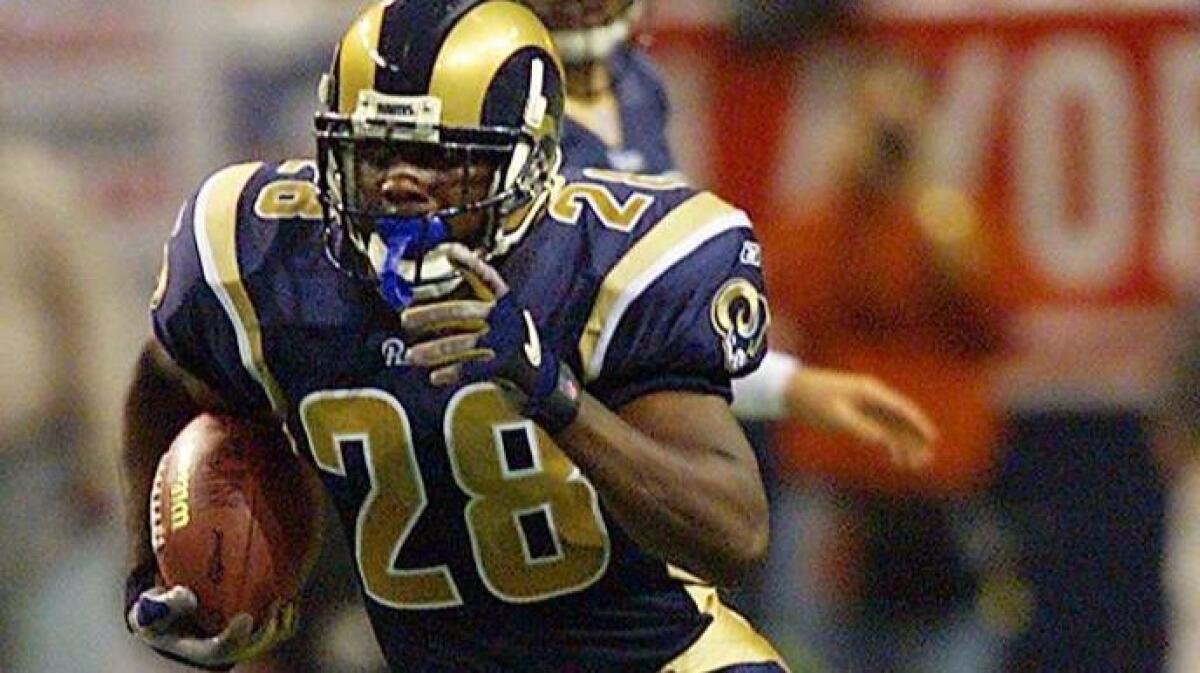With his impressive receiving skills, Rams’ Todd Gurley could join an exclusive club
- Share via
Roger Craig of the San Francisco 49ers did it first in 1985.
Marshall Faulk of the St. Louis Rams accomplished the feat 14 years later.
They are the only NFL running backs to rush for 1,000 yards and have 1,000 yards receiving in the same season.
Now, Craig, Faulk and others are pleased to see Rams running back Todd Gurley catching more passes.
Gurley enters Sunday’s game against the Seattle Seahawks at the Coliseum with 362 yards rushing and 234 yards receiving.
The 2015 NFL offensive rookie of the year’s rebound from a subpar 2016 season was not entirely unexpected. But Gurley’s emergence as a receiver under first-year coach Sean McVay has been something of a revelation.
“We just try to find ways to get players in good situations and try to put them in spots that kind of help bring out their strengths,” said McVay, who has turned what was the NFL’s worst offense into the highest-scoring unit.
Gurley caught 21 passes as rookie, 43 last season. The transition to an increased receiving role in McVay’s scheme has apparently not been difficult.
“I’ve done it so much in practice,” he said, “that it’s second nature in the game.”

Gurley’s rise as a receiving threat has coincided with second-year quarterback Jared Goff’s development. Goff, the No. 1 pick in the 2016 draft, has completed 78 passes this season, a team-high 20 to Gurley.
“It’s relieving when I get through my progression and see him wide open,” Goff said. “It’s like, ‘Ah, here we go, it’s an easy one.’ ”
Gurley’s evolution as a receiver has included several noteworthy receptions:
— In Week 2 against the Washington Redskins, he caught a swing pass to the left side and hurdled a defensive back en route to the end zone.
— In Week 3 against the 49ers, he caught a short pass on third and 10 and turned it into a 27-yard gain that kept alive a drive.
— Last week against the Dallas Cowboys, Gurley caught an 18-yard pass and turned it into a 53-yard scoring play.
“I saw him make a one-handed catch earlier this season,” Craig said. “I said, ‘Damn, this guy is amazing.’ They should have been doing this a long time ago.”
In coach Bill Walsh’s West Coast offense in the 1980s, Craig established the standard for pass-catching running backs.
Craig played fullback in college at Nebraska and caught only 16 passes.
But when he heard that Walsh was considering selecting him in the 1983 draft, he went to work.
“I’m like, ‘Oh my God, I’ve got to learn how to catch the ball,’ ” Craig said. “I was freaking out.”
Craig said he began catching 100 passes a day. After he was drafted, he reported to rookie camp and said quarterbacks coach Paul Hackett threw him 100 passes in double-day workouts.
“I only missed two,” he said. “One went over my head and one was too low.”
Craig, playing fullback, caught 48 passes as a rookie, 71 the next season. In 1985, he led all NFL players with 92 catches for 1,016 yards and six touchdowns. He rushed for 1,050 yards and nine touchdowns.
Craig noted that Arizona’s David Johnson, who has been sidelined because of a Week 1 wrist injury, Pittsburgh’s Le’Veon Bell and Gurley are capable of joining the 1,000-1,000 club.
“I was the first,” he said. “I want to see it grow.”
Faulk, who starred in college at San Diego State, came close to joining Craig in 1998 when he rushed for 1,319 yards and caught 86 passes for 908 yards.
The next season, with Mike Martz as the Rams’ offensive coordinator, Faulk rushed for 1,381 yards and seven touchdowns, and caught 87 passes for 1,048 yards and five touchdowns as the Rams made their run to a Super Bowl title.

Faulk, a Pro Football Hall of Fame member and NFL Network analyst, has monitored Gurley’s career since the Rams selected him with the 10th pick in the 2015 draft. During his first two seasons, Gurley was often replaced in passing situations.
“I’m not a guy that’s comfortable with all the platooning,” Faulk said. “It’s a necessity to have your best player on the field as much as possible, because you never know when that check-down or that swing route might be the play to make a difference in the game.”
Gurley’s pass-catching ability and McVay’s knowledge about how to exploit talent has helped key the Rams’ run to a 3-1 record and first place in the NFC West.
“Those two things, when brought together, it can be dangerous,” Faulk said.
He added that Gurley was beginning to understand that pass plays are “extended handoffs” that put running backs in favorable matchups.
“It gets you away from the defensive linemen, and now it’s you and a linebacker or you and a safety or you and a defensive back,” Faulk said. “You’ve just got to make them miss.
“He’s figured that out, and now he’s figuring how it affects the game.”
Hall of Famer Marcus Allen probably would have been a member of the 1,000-1,000 club if not for Al Davis, the late Oakland Raiders owner who seemed hell-bent on limiting Allen’s touches.
“He could have been a 1,000-1,000 guy, easy,” Craig said.
Allen came closest in 1984, when he rushed for 1,168 yards and caught 64 passes for 758 yards.
Allen, the 1981 Heisman Trophy winner at USC, said Gurley’s catch-and-run touchdown play against the Cowboys epitomized the value of running backs as receivers. And coaches such as McVay who deploy them.
“When you have the ability to catch the ball and you’re not just a one-dimensional back, you don’t ever have to leave the field,” Allen said. “We know he’s strong, fast, quick and all those things.
“It’s amazing how an offense that couldn’t get out of its own way last year is now so dynamically different. So far it amazing.”
But can Gurley keep the pace?
McVay said that coaches and the training staff would monitor Gurley, who is averaging nearly 27 touches a game.
“Whether we tailor that back or not is going to be predicated on how he feels,” McVay said.
Gurley welcomes the opportunities.
“You don’t definitely want to regret anything and go into this offseason and be like, ‘I wish I would’ve been able to play a couple more snaps,’ ” he said. “That’s why I work so hard. To be in the position that I’m in today.”
Follow Gary Klein on Twitter @latimesklein
More to Read
Go beyond the scoreboard
Get the latest on L.A.'s teams in the daily Sports Report newsletter.
You may occasionally receive promotional content from the Los Angeles Times.







